As climate concerns continue to shape urban development, Victoria’s business districts are embracing a greener future—literally. In 2025, commercial landscaping trends are aligning closely with the city’s sustainability goals, showcasing how public and private sectors are using thoughtful design, native plants, and environmentally responsible practices to revitalize urban spaces. Let’s explore what’s growing in Victoria’s commercial landscape this year—and what it means for the future.

1. Sustainability First: Eco-Conscious Landscaping Takes Root
To begin with, sustainability is no longer a buzzword—it’s a baseline. Commercial property owners and developers in Victoria are increasingly prioritizing landscapes that reduce water use, cut down on maintenance costs, and promote long-term ecological health. For instance, low-water irrigation systems such as drip irrigation and smart controllers are quickly becoming standard across shopping centres, office parks, and even public plazas.
Additionally, incorporating permeable paving is another trend gaining momentum. These materials allow rainwater to filter through rather than run off, helping to prevent urban flooding and recharge groundwater. Notably, these paving systems are especially popular in developments that border downtown waterways and storm-sensitive areas.
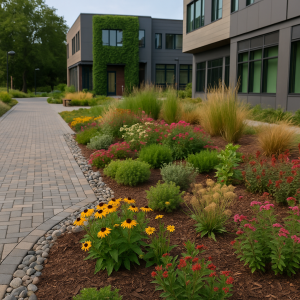
2. Native Plantings: Thriving in the Coastal Climate
Alongside sustainability efforts, Victoria’s commercial landscapers are shifting toward native plant landscaping, a trend that has seen a significant rise in recent years. Indigenous species like Oceanspray (Holodiscus discolor), Red-flowering currant (Ribes sanguineum), and Kinnikinnick (Arctostaphylos uva-ursi) are increasingly replacing ornamental imports. Not only are these plants drought-tolerant and low-maintenance, but they also support local pollinators and wildlife.
A great example of this approach is IslandEarth Landscape Company. As a leader in sustainable commercial landscaping on Vancouver Island, they’ve championed the use of native plants in high-visibility projects such as medical campuses and retail complexes. Their designs not only reduce irrigation needs but also improve ecosystem resilience and create natural beauty that reflects the region’s identity.

3. Design Meets Function: Integrating Landscaping with Urban Planning
At the same time, 2025 is seeing a clear shift toward integrated urban design, where landscaping is not an afterthought but a central element of planning. In Victoria’s rapidly developing downtown core, green spaces are being woven into the fabric of the city through living walls, rooftop gardens, and streetside rain gardens.
Moreover, this integration goes beyond aesthetics. Landscape architects are now collaborating with engineers and architects to ensure commercial landscapes help manage stormwater, reduce the heat island effect, and provide public rest areas. For example, new developments near Johnson Street and the Inner Harbour are incorporating layered plantings and green buffers to soften urban density and improve air quality.
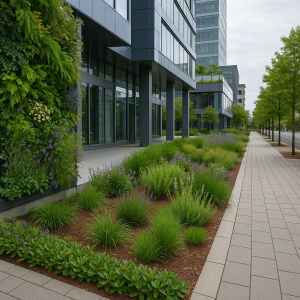
4. Year-Round Appeal: Evergreens and Multi-Season Interest
In addition to climate responsiveness, Victoria’s temperate weather allows for year-round landscaping, and businesses are increasingly opting for plant palettes that deliver visual interest in all seasons. Commercial landscapes are now including ornamental grasses, winterberry, hellebores, and evergreen shrubs like Pacific rhododendron to maintain curb appeal regardless of the season.
As a result, this trend supports both branding and first impressions, while also extending the usability of outdoor commercial spaces. Landscaped courtyards and patios are becoming multi-functional areas—ideal for outdoor meetings, customer seating, or seasonal events.
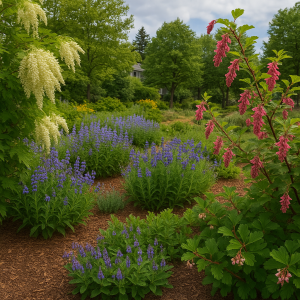
5. Technology-Enhanced Green Spaces
Furthermore, digital integration is reshaping how landscapes are monitored and maintained. From soil moisture sensorsto app-controlled lighting and irrigation systems, smart landscaping tools are making it easier for businesses to maintain healthy and efficient green spaces. In 2025, these systems are being widely adopted by property managers who want precise data to reduce water usage and optimize maintenance routines.
To illustrate, IslandEarth Landscape has integrated this tech into their routine care packages for commercial clients, helping reduce long-term costs and streamline upkeep while supporting sustainability metrics.
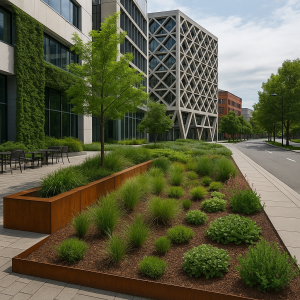
Challenges on the Path to Greener Spaces
Despite the growing popularity of green practices, several challenges remain. For instance, initial installation costs for systems like permeable paving or smart irrigation can be high, especially for small businesses. Ongoing maintenance of green roofs or vertical gardens may also require specialized knowledge or service contracts.
In addition, navigating municipal zoning bylaws and city permits for certain green features can delay implementation. However, Victoria’s growing support for green infrastructure—reflected in city grants and incentives—is helping to offset these challenges and encourage innovation.
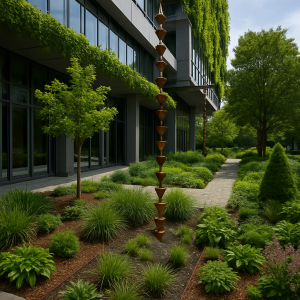
Looking Ahead: Green is the New Standard
Ultimately, Victoria’s business districts are in the midst of a green transformation that reflects broader societal values—climate responsibility, community wellness, and natural beauty. As these 2025 trends take hold, they’re not just reshaping the visual identity of the city—they’re redefining how commercial spaces function, engage with the environment, and contribute to a healthier future.
From native gardens that echo the island’s wild charm to tech-enabled ecosystems that quietly conserve resources, Victoria’s commercial landscapes are proof that sustainable design is smart design. And with leaders like IslandEarth Landscape at the helm, it’s safe to say this green momentum will only continue to grow.